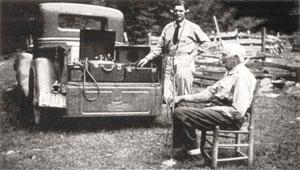In 1939 a young graduate student named Joseph S. Hall spent nine months getting to know the people living in and around the newly created Great Smoky Mountains National Park, and recording their music and stories. Hall's mission was to preserve as much as he could before a unique culture had dispersed.
Hall's work with the mountain people quickly became a labor of love. According to a park spokesperson, "He bunked in their homes, worked at their sides putting up hay and hanging tobacco, and attended church services and reunions. He recorded their stories, music, and speech, all without pretension or preconceived notions. Unlike other researchers with a point to prove, Hall pretty much just turned on his machines and let people say or play whatever they wanted. Throughout his life Hall insisted that his materials never be used to cast his mountain friends in an unfavorable light."
Historic Recordings Meet New Technology
At the time, Hall couldn't have envisioned that one outcome'over 60 years later'would be a much different kind of recording known as a compact disc, which had now been nominated for an award called a Grammy.
That CD, "Old-Time Smoky Mountain Music," was produced by the park's nonprofit educational partner, Great Smoky Mountains Association. The disk includes 34 historic songs, ballads, and instrumentals drawn from Hall's 1939 project.
Almost as valuable to fans and students of traditional mountain music are the written information and photos included with the CD. When the Association embarked on the project, the producers issued news releases throughout the region to track down any surviving musicians featured on the recordings, or their descendants.
According to an Association spokesperson, the response "exceeded their expectations. At least 18 relatives of the original musicians featured on the CD responded enthusiastically and sent photographs and anecdotes about their relatives. Two of the musicians recorded in 1939 were still alive.
Liner Notes Provide a Wealth of Information
The photos and information were incorporated into the 40-page liner note booklet that accompanies the CD." Key to the development of the CD and the liner notes were three scholars: Dr. Michael Montgomery of the University of South Carolina, Dr. Ted Olson of East Tennesee State University, and Park Ranger Kent Cave of Great Smoky Mountains National Park.
Dr. Montgomery has dedicated decades to preserving Hall's works and publishing materials related to his collections, including the Dictionary of Smoky Mountain English. Dr. Olson is an accomplished banjo player and professor of Appalachian Studies. He is also editor of the Journal of Appalachian Culture. Ranger Cave is a renowned expert on Smoky Mountain history and co-editor of Smokies Life Magazine, History Hikes of the Smokies and many other publications. Recording live music and conversations "in the field" was a lot more complicated in 1939.
Hall used a Garwick machine that produced aluminum discs and was operated by cables hooked to a pick-up truck battery and an Allied machine that made acetate discs and ran on a portable battery pack.

Joseph Hall recording a story by 86-year-old Steve Woody, a life-long resident of the Smokies, in 1939. NPS photo.
The recording process might have been pretty cumbersome, but finding music in the Smoky Mountains during the 1930s was not a difficult task. Family bands were common, with everyone from toddlers to Grandpa singing and playing an instrument. Songs were passed down through generations like precious china. As one performer's daughter remarked, 'If it had strings, someone in our family could play it.'"
This "Mountain Music" is the Real Deal
If you've heard current versions of "mountain music" you might be surprised when you listen to this CD. According to a park spokesperson, "The music Hall captured during that summer in the Smokies barely resembles the 'music of the mountains' we are presented with today. Bluegrass had not even been invented yet. And the styles were diverse: traditional ballads from the British Isles, American ballads, lyric folk songs, African-American blues-based songs, hymns, country, and gospel."
"Performers Hall recorded were influenced both by their unique traditions as well as modern inventions like record players and radios. Even though the stereotypical mountain cabin had no such appliances and its residents were thought to be utterly cut off from the outside world, in reality, even in 1939, many folks gathered around their music machines to listen to stars like Jimmie Rodgers, the Carter Family, and Roy Acuff. Their music evolved like music everywhere, blending the old and new, the local with the national."
Songs featured on the CD include 'My Home Is in the Smoky Mountains,' 'Don't Forget Me Little Darling," "Mule Skinner Blues," "Ground Hog," "On Top of Old Smoky," and "Up on Pigeon River." You can listen to sample clips from the disk at this link.
If you'd like to purchase a copy of the CD, you can do so from the Association's website or by phoning 1-888-898-9102 x226.




Add comment